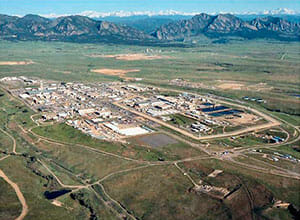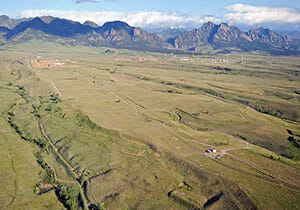Earlier this week, I attended a committee meeting in Denver. The participants were educators who lived in various places along the Front

Image borrowed from EPA website
Range. As an icebreaker, each participant was asked to share information about a current read. When I started talking about Full Body Burden: Growing Up in the Nuclear Shadow of Rocky Flats by Kristen Iversen, I was astounded to learn that not everyone had heard of Rocky Flats.
From 1952-1989, Rocky Flats produced triggers for nuclear weapons. The government closed the facility at the end of the Cold War due to public concerns for the safety of thousands of employees and the health of the people who lived in nearby communities. Between 1995 and 2007, the US government attempted to clean up this contaminated site. A significant amount of radioactive and toxic materials remains buried on the site while tons of radioactive and hazardous materials were shipped to other states. The whereabouts of over 2500 pounds of plutonium still remains a mystery. According to Kristen, bookkeeping mishaps were the culprit.
During the remediation process, the Rocky Flats Stewardship Council was formed and is still an active organization. It includes elected officials from nine municipal governments neighboring Rocky Flats, three community organizations, and one individual. This entity monitors the data that is collected by the Department of Energy, the Colorado Department of Public Health and Environment, and the Environmental Protection Agency. Currently, the ground water is monitored at 100 sites within the boundary of the former Rocky Flats facility. The test results consistently surpass the US government regulations. Toxins are not being added to the ground water or any nearby lakes or streams. At the present time, air and soil testing are no longer deemed necessary.
I became aware of Rocky Flats in the 1970s when I attended the University of Colorado-Boulder. Anti-war protesters flocked to the site to make their voices heard. Many students joked about how this location glowed in the dark and that the Russians had placed it first on their list of US bombing targets. After I moved back to Chicago, Rocky Flats became a distant memory.
In 2000, my family relocated to Colorado. Our top choice was a home just a couple of miles north of the infamous Rocky Flats. Was it safe to live in Superior?
I asked realtors, locals, and the builder. No one raised any issues. A superficial Internet search yielded little information. One native Coloradoan felt that it was safe since cattle and assorted wildlife grazed in the area without any noticeable issues. He apparently was unaware of, or did not give credence to, the animal studies that Kristen mentions in her book.
We moved to the family friendly community of Superior. I rarely thought about Rocky Flats unless it was mentioned in the news. I did find it a bit odd that a place that once was a focal point for the production of nuclear triggers would soon be turned into a federal wildlife sanctuary. The Rocky Flats National Wildlife Refuge plan calls for 12.8 miles of multi-use trails and 3.8 miles of hiking-only trails. Approximately 1/3 of the former Rocky Flats land is still considered unsafe and will remain closed. The lack of sufficient federal funding has delayed the opening of the refuge.

Image borrowed from EPA website
While I was learning about the pros and cons of creating a video book trailer for my memoir, May This Be the Best Year of Your Life, I watched Kristen Iverson’s book trailer. I immediately wondered whether her memoir would be a factual account of what happened. Would she manipulate the facts to fit her agenda? I would have to reserve judgment until I found time to read her popular and award winning book.
Growing up in the vicinity of Rocky Flats and later working at the facility, Kristen had an insider’s view. She combines her first-hand observations with the facts that she gathered from a multitude of sources over many years. Without being privy to all of the original documentation or the conversations, it is not possible to determine whether her story is biased or an accurate retelling of the events. I defer to people who know more facts.
I contacted the David Abelson, executive director of the Rocky Flats Stewardship Council. I heard another side to the story. Space does not allow time to discuss the specifics. The bottom line is that Kristen’s memoir has a definite agenda and should be read with a discerning eye.
Watching friends, relatives, and coworkers be stricken by an unusually high incidence of cancer and illness had to be alarming. Was it possible in all cases for her to attribute all medical issues to working at Rocky Flats or living nearby? I’m not sure. One cannot dismiss the negligence that resulted in serious nuclear accidents, the mishandling of nuclear waste and the two major fires in 1957 and 1969 when unknown quantities of plutonium were released into the air. However, these incidents were more in the public eye than she reveals.
The mishandling of toxic elements also caused the contamination of local water systems. Prior to the closing of Rocky Flats, significant amounts of plutonium were detected in Woman Creek, Walnut Creek, Standley Lake, and the Great Western Reservoir. Ground water at one point carried tritium, a known toxin, to Broomfield’s water supply. After detection, a new reservoir was created. Subsequent windstorms caused some of these hazardous particles to disperse over miles and pollen innocently carried toxic materials away.
Why should one be worried about plutonium? A lethal dose of plutonium is a microgram- a millionth of a gram. Toxicity results when plutonium is inhaled or ingested. Unlike x-rays that can penetrate through the skin, plutonium emits alpha radiation that cannot infiltrate the skin. However, if the particles are inhaled, ingested with food or water, or enter through an open wound, the alpha particles have the potential to wreck havoc with the body’s immune system. The end result is an increased likelihood of cancer.
It is not surprising that some medical studies in the 1960s and 1970s showed an increase of cancer in areas down wind of Rocky Flats. Residents also reported undiagnosed symptoms such as unexplained exhaustion, fever, and swollen lymph nodes. A large number of workers succumbed to fatal forms of cancer and suffered from Beryllium disease. There is little doubt that the lack of safety precautions was a contributing factor. However, it is difficult to point to Rocky Flats as the only cause for all of these health issues.
Did the greed of the Rocky Flat contractors- Dow Chemical and Rockwell International- put safety measures on hold? Did the federal agencies, local municipalities, and local building associations disregard the health of nearby residents? Did the court system not provide justice for all of the injured parties? Kristen paints a bleak picture of the culpability of all of these entities when she attempts to address these questions. Other points of view need to be examined before one can form an educated opinion.
I spoke with Carl Spreng, project manager at the Colorado Department of Public Health and Environment overseeing environmental restoration at Rock Flats site. He told me about the voluminous reports that support the decision to have the wildlife refuge land be designated as an unrestricted area. His agency has been monitoring the area for decades. When asked if Kristen ever contacted his office, he replied, “No!”
It should not be forgotten that Rocky Flats was not the only source of plutonium. The fallout from US nuclear tests in the 1950s and 1960s left low concentrations in soil around the world. Nuclear plants in the US and elsewhere have also released plutonium and other toxins into the atmosphere. Unfortunately, plutonium undergoes radioactive decay that has a half-life of up to 24,100 years and therefore needs to be handled professionally.
Chernobyl (1986) and Fukushima (2011) have illustrated how far toxins can travel. After the most recent nuclear disaster in Japan, low levels of radiation from Fukushima were recorded on US soil. There is no way to escape low level exposure to plutonium. However, living near an active site obviously increases the risk of exposure.

In the 1990s, the U.S. Department of Energy (DOE) performed a Baseline Risk Assessment and Environmental Risk Assessment that evaluated the ground water, soil, and sediment for the area now known as Candelas, a new community just south of the wildlife refuge. The developers of Candelas did further testing in 2011 and 2013 using Ludlum 19 Micro-R Meters to measure gamma radiation readings. Their study showed background readings that ranged from 7 to 18 micro-roentgens per hour (uR/hr). Environmental staff scientists at CTL Thompson, Inc. reached the conclusion that “uR/hr emissions are generally similar to background levels in the area and are generally the same or lower than others collected by CTL in the Denver Metro area… The Highlands Ranch area has a reading of 19 uR/hr.” CTL Thompson’s report concurs with the DOE Corrective Action Decision/Record Decision that concluded that the land could be developed for residential use.
New homes are being built and more people are starting to live within a couple of miles of the former nuclear trigger factory. Anyone considering living near Rocky Flats or any other nuclear facility should have a comfort level with his/her decision. Assessing levels of risk and safety can be complicated when trying to pull strands of truth from biased materials. Care needs to be taken to become as well informed as possible.
Related Blogs
Rocky Flats National Wildlife Refuge: Monthly Nature Programs
Assessing Risks- Living Near Rocky Flats
Candelas and National Wildlife Refuge
Blog Highlighting Events at Candelas
Benefits to Living Near a School
Bio
Sandra Bornstein is the author of MAY THIS BE THE BEST YEAR OF YOUR LIFE. It is available on Amazon.
Sandra’s memoir highlights her living and teaching adventure in Bangalore, India. She is a licensed Colorado teacher who has taught K-12 students in the United States and abroad as well as college level courses. Sandra is married and has four adult sons.
The memoir was a finalist in the Travel category for the 2013 Next Generation Indie Book Awards, the 2013 International Book Awards, the 2013 National Indie Book Excellence Awards, 2013 USA Best Book Awards, and a Honorable Mention award in the Multicultural Non-Fiction category for the 2013 Global ebook Awards.
Excellent article and report on the complexity of the nuclear test site. Due to past security concerns, much about the nuclear labaoratories, testing and contamination may be hidden for as long as possible.
Steve, I’m hoping the federal, state, and local governments will learn from the mistakes that were made at Rocky Flats. While not all of the land was able to be remediated, a significant amount was restored to its original natural beauty. Nevertheless, we will have to wait and see if the measures taken are successful and all of the known contaminants are contained. Obviously, it is not possible to address the toxins that may have traveled offsite or were not detected on the site. Unfortunately, this is a problem that is shared by all nuclear facilities. From what I could ascertain from talking to people who monitor the site, every effort is being made to ensure that the nearby residents will be protected. We will have to wait and see.